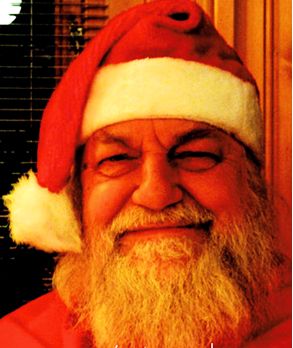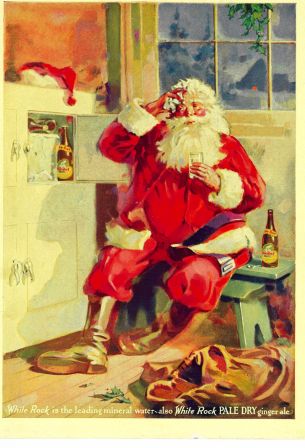 Inspired by this brilliantly witty publicity photo of the English singer Robert Wyatt costumed as Santa Claus I am going to rope together two quite unrelated pieces of research in an act of seasonal generosity.
Inspired by this brilliantly witty publicity photo of the English singer Robert Wyatt costumed as Santa Claus I am going to rope together two quite unrelated pieces of research in an act of seasonal generosity.
1. Wyatt isn’t really Santa Claus–he used to be a member of the Communist Party. It’s false consciousness. And, er, he is well known for his falsetto singing. Ah. Right. So [from work in progress Shakin’ All Over: Popular Music and Disability]:
The first form of voice I want to consider is that commonly employed by someone like Robert Wyatt, a drummer who became a man with paraplegia and a wheelchair user and altogether more of a singer following an accident in 1973: falsetto. Wyatt is an intriguing case. In his own somewhat ambivalent view, the voice is
a very difficult instrument to play, if you’ve only got my technique anyway…. I can’t listen to singers the way I listen to other musicians—I get really embarrassed when singers start doing funny things with their voice that clearly they wouldn’t do in the normal course of your average telephone conversation. In a way I find it a limitation, I’m only comfortable singing fairly close to speech patterns.
Yet while hugging speech patterns in his vocal delivery—and more, pursuing an ostentatious Englishness (that is, non-transatlanticism) in his singing accent from his earliest days in the 1960s with the Wilde Flowers and Soft Machine on—there remains the question of Wyatt’s falsetto. To sound thus is surely ‘doing funny things with the voice’ and a delivery not normally heard in a telephone conversation, after all. So I have in mind the falsetto voices employed by disabled male singers like Wyatt and polio survivor, epileptic, father of disabled children and active fundraiser for disability groups Neil Young, or the visually impaired indigenous Australian singer Geoffrey Gurrumul Yunupingu, or of Curtis Mayfield in his later quadriplegic years. I consider them as sonic signifiers of vulnerability and sensitivity, which are themselves in turn characteristics frequently connected by fans, other musicians and music journalists, as well as by these artists’ marketing people, to their perception of the artists’ disability-related pain and suffering….
2. [Extracted from a 2008 essay, ‘Consumption, “coca-colonisation, cultural resistance–and Santa Claus’] …the figure at the heart not only of Christmas but of the profound transformation of this festival season, the overweight and elderly superhero, the ‘deity’ of materialism (Daniel Miller’s word), known as Santa Claus, with his amazing sackful of magic powers—flight, shape-shifting, time travel, omniscience… For,  as James B. Twitchell has observed, ‘You can keep Christ out of Christmas but not Santa’…. A normative whiteness–the caucasian appearance, white hair and beard, white fur trim–and reassuring masculinity–unthreatening, paternal (Father Christmas) or avuncular–are embodied by representations of Santa Claus. This is so from the early popularisation of a visual image in January 1863 (marking the Christmas 1862 season–perhaps we can say that Santa Claus was also born at Christmas) by Thomas Nast on….
as James B. Twitchell has observed, ‘You can keep Christ out of Christmas but not Santa’…. A normative whiteness–the caucasian appearance, white hair and beard, white fur trim–and reassuring masculinity–unthreatening, paternal (Father Christmas) or avuncular–are embodied by representations of Santa Claus. This is so from the early popularisation of a visual image in January 1863 (marking the Christmas 1862 season–perhaps we can say that Santa Claus was also born at Christmas) by Thomas Nast on….
That most obvious of deconstructions, Santa/Satan….
[For contemporary radicals like Adbusters t]o state, or reinstate, the possibility of the carnivalesque irruption of festival was the aim, to be achieved by stepping out of the social frame of consumerist culture and practice. In malls  and shopping streets, Zentas rather than Santas began to appear, the idea being for the anarchist–robed for the day in red and white rather than red and black–to project an ironic zen-like calm rejection of frantic consumption, with the handy extra activist practicality that adopting the position of cross-legged meditation was also effectively a sit-down protest blockade. At Buy Nothing Christmas actions, Santa/Zenta Claus reaffirmed his place in ideological and social debates, just as he had been in Nast’s Civil War illustrations of 150 years before.
and shopping streets, Zentas rather than Santas began to appear, the idea being for the anarchist–robed for the day in red and white rather than red and black–to project an ironic zen-like calm rejection of frantic consumption, with the handy extra activist practicality that adopting the position of cross-legged meditation was also effectively a sit-down protest blockade. At Buy Nothing Christmas actions, Santa/Zenta Claus reaffirmed his place in ideological and social debates, just as he had been in Nast’s Civil War illustrations of 150 years before.
3. But I am not buying nothing this Christmas–I am buying Robert Wyatt’s Christmas single, a version of Louis Armstrong’s ‘What a wonderful world’. After all, it has a great advertising campaign, featuring this chap in a beard….
